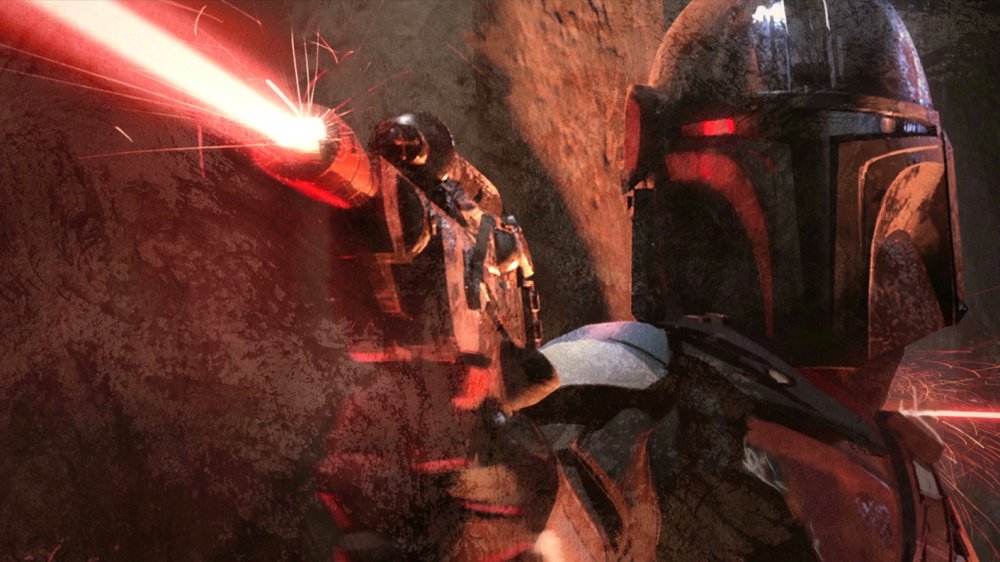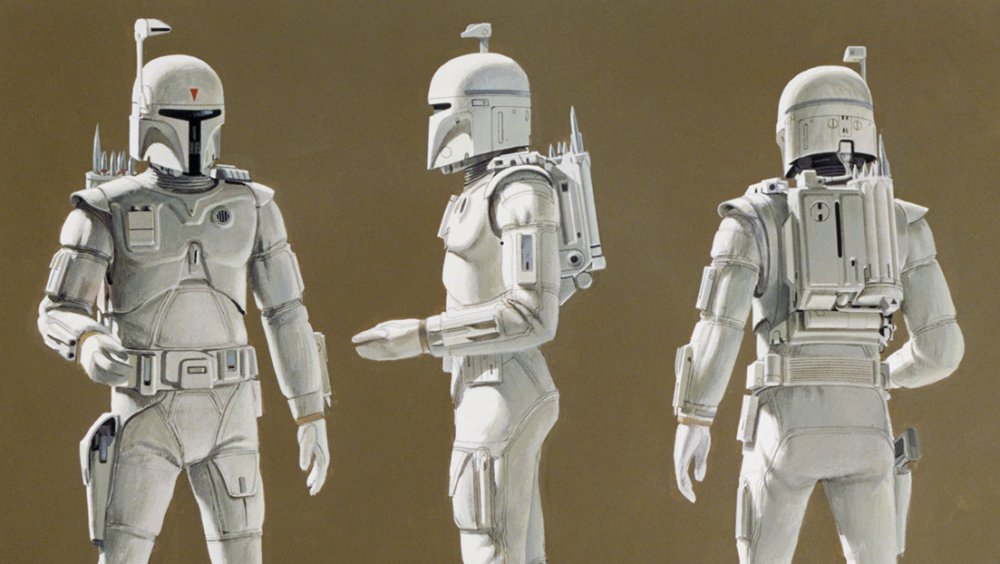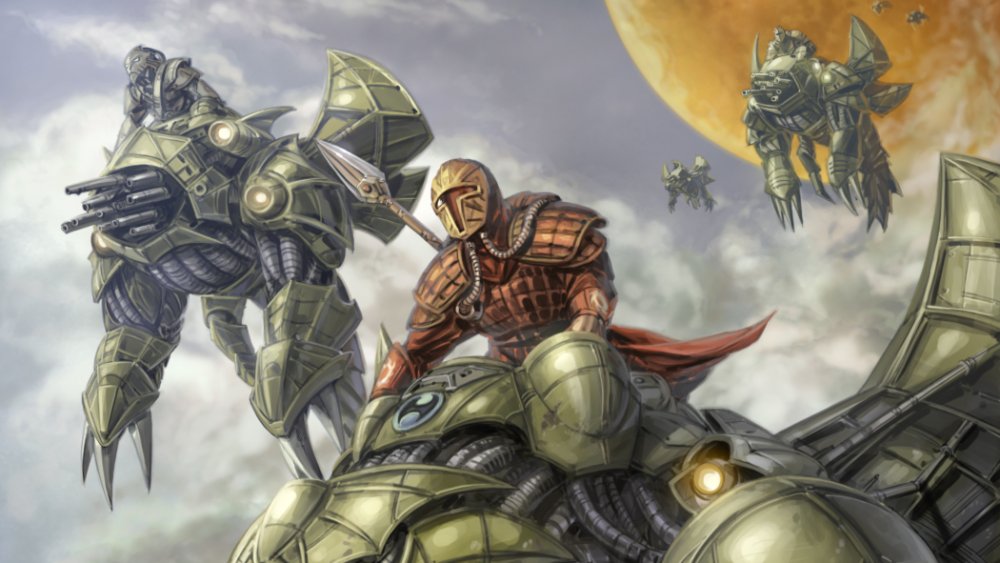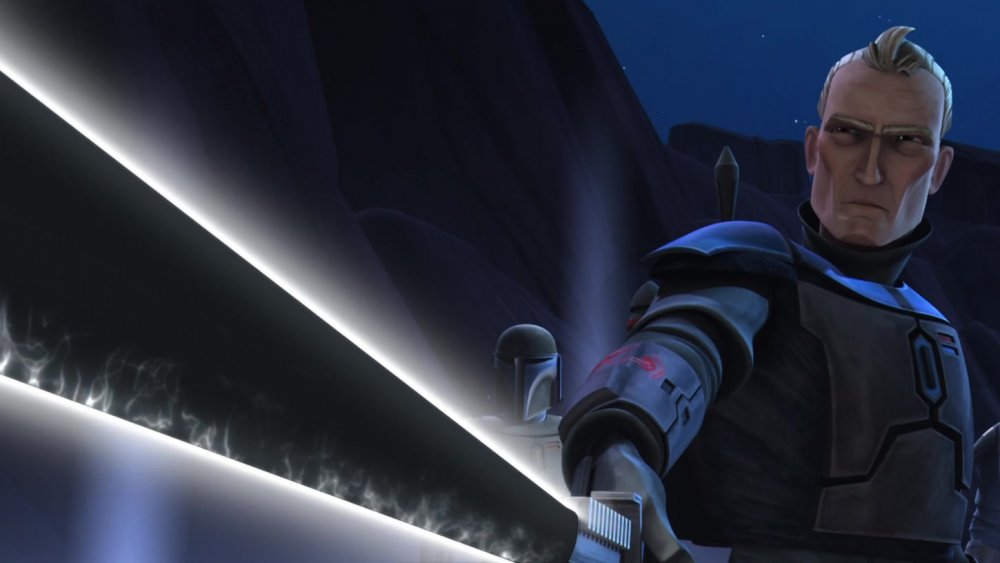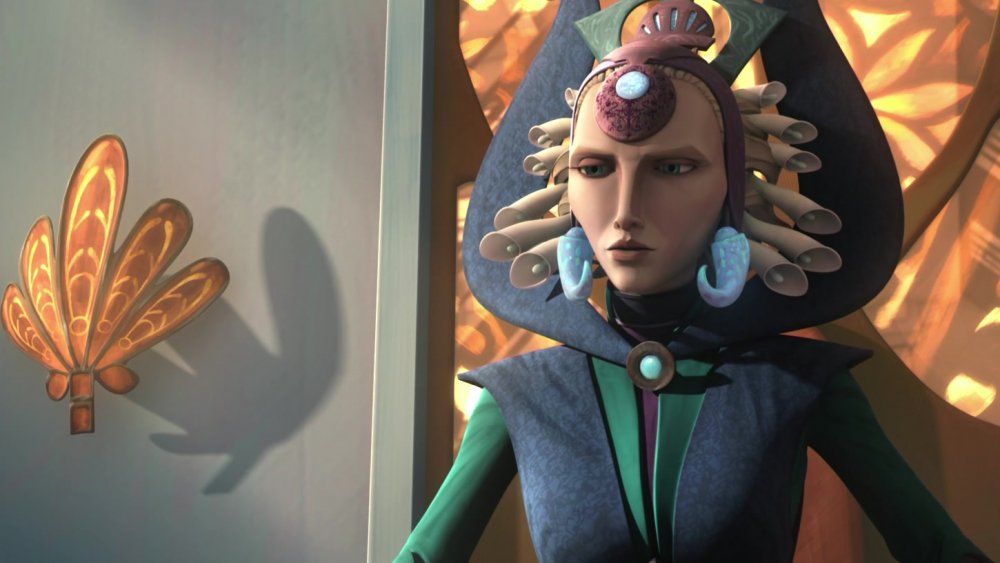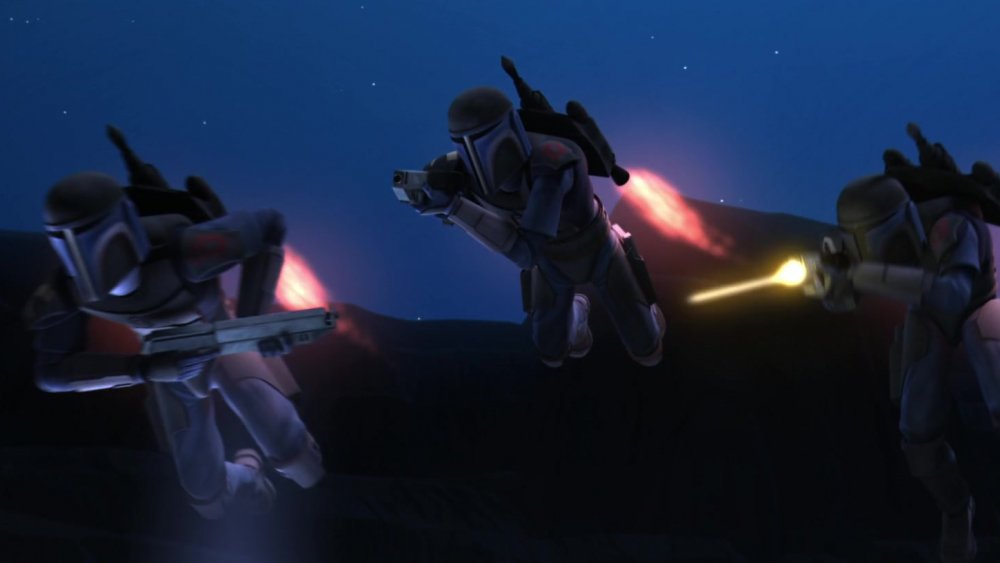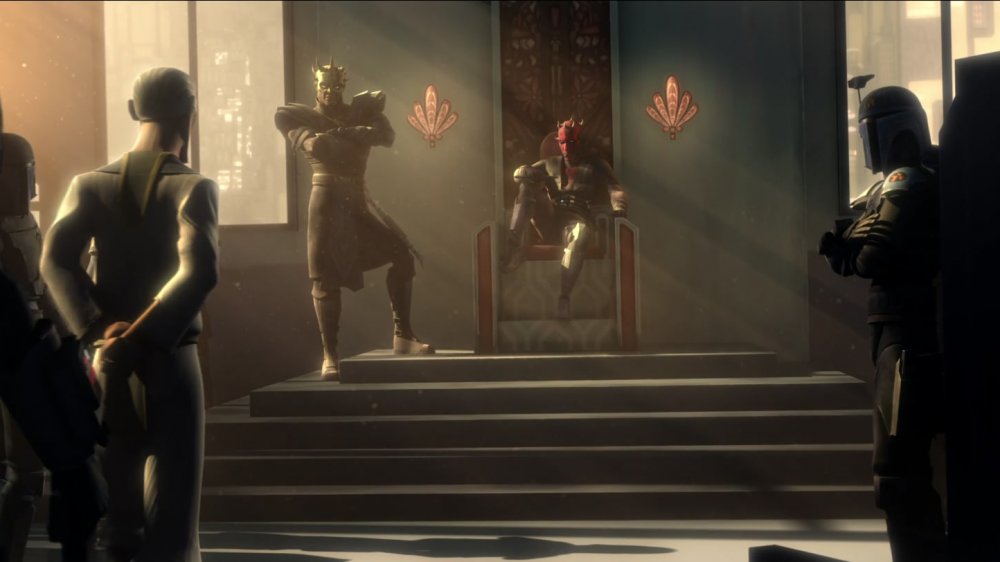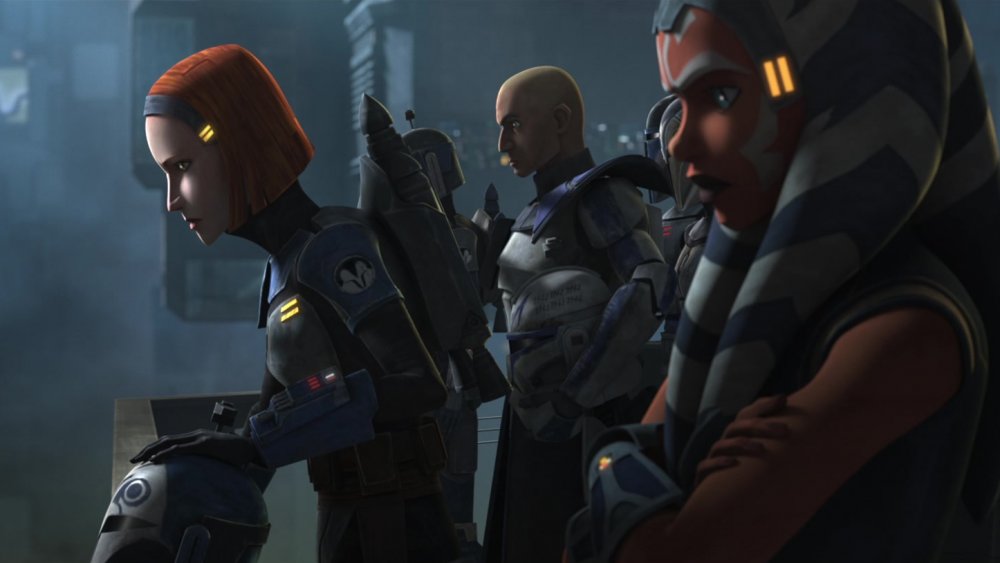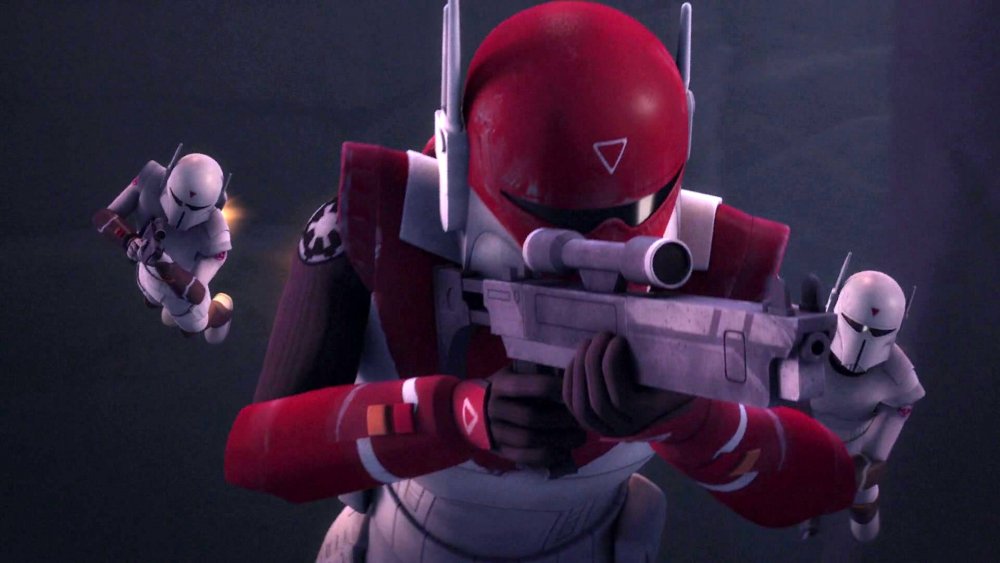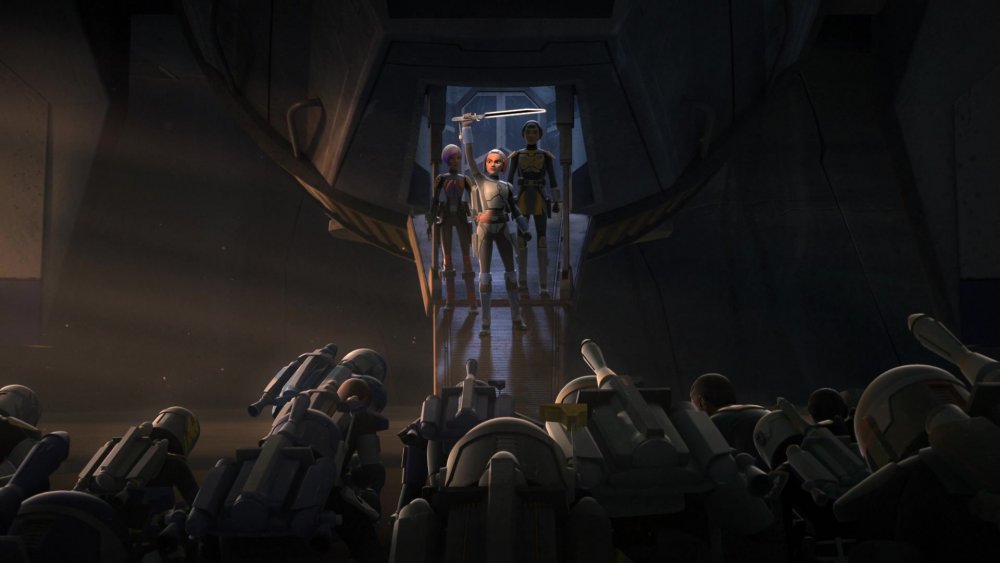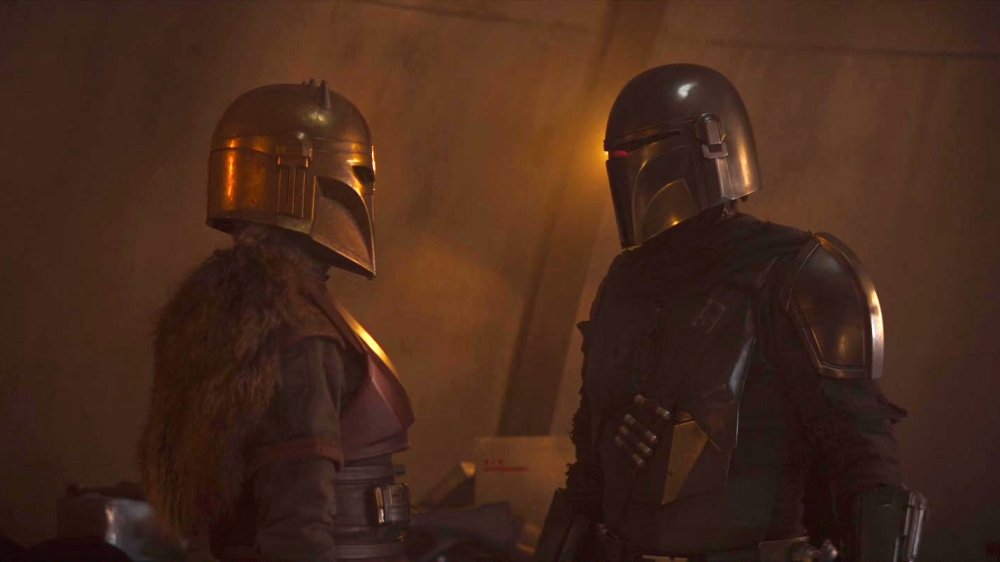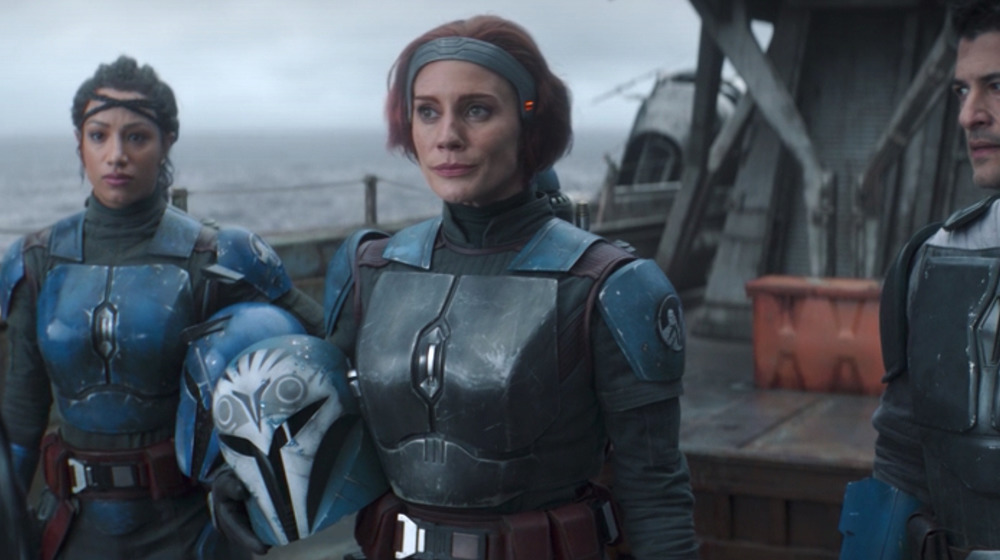The History Of Mandalore Explained
Never underestimate the value of a great costume design.
In the lead-up to the release of The Empire Strikes Back in 1980, fans were introduced to a new minor character that captured their imaginations. Teased in the 1978 Star Wars Holiday Special and promoted with a popular action figure, fans already knew the name Boba Fett before he even appeared on the big screen — ironic, considering he's only referred to as "bounty hunter" in the actual film. Even after he was apparently killed in an embarrassing fashion in Return of the Jedi, Star Wars fans loved Boba Fett for one simple reason: that armor is freaking cool, too cool to waste on a scrub who falls into a pit and gets eaten by a giant worm.
Flash forward four decades, and the armor has taken on a life far beyond Boba Fett. Through comics, novels, television, and video games, a rich mythology has been built around this famous suit of armor, the culture it represents, and the planet it hails from — a mythology that has almost nothing to do with the character who first made it famous.
The saga of the planet Mandalore is spread across '90s comic book series Tales of the Jedi, the animated series The Clone Wars and Star Wars Rebels, and the more recent live-action series The Mandalorian, but as always, it begins right here in our world with a few sharp creative minds, a deadline and a budget. This is the history of Mandalore explained.
Mandalore was invented for The Empire Strikes Back
After the runaway success of the original Star Wars in 1977, the future was wide open for sequel The Empire Strikes Back. Among the many abandoned concepts for the second part of the original trilogy was an army of Imperial Super Troopers, armored badasses from the Mandalore system. As conceived by George Lucas and designed by visual effects supervisor Joe Johnston and concept artist Ralph McQuarrie, the Super Troopers would have an ancient grudge against the Jedi and an array of weapons integrated into their suits to combat them.
These concepts would end up forming the basis of Mandalorians as we know them much later, but at the time, the budget simply didn't exist to manufacture dozens if not hundreds of these new costumes, which were much more intricate than the stormtrooper outfits created for the first film. The idea of Super Troopers was scrapped, but the design was undeniably great and a new, individual character was conceived to wear it — the bounty hunter Boba Fett. The costume was given some color and some wear to give it a sense of history and to distinguish it from proper Imperial attire.
Like "Sith" or "Palpatine," the words "Mandalore" and "Mandalorian" are never uttered in the original trilogy, but fans came to know it and associate it with the armor through the wealth of ancillary material released about the film universe throughout the 1980s and '90s.
The Mandalore of Legends has a long, bloody history
The fact that Boba Fett says and does very little in his first two film appearances did nothing to dampen fan enthusiasm to learn more about him and the origin of his slick armor. The original Star Wars Expanded Universe — comprised of novels, comics, video games, and tabletop RPG sourcebooks published between 1978 and 2014 — offered an enormous amount of information about the bounty hunter and the culture from which he hails, the Mandalorians. Their homeworld of Mandalore became the setting of many stories and home to an army of characters wearing variations on the beloved costume design.
Mandalore is established to be a planet on the Outer Rim of the galaxy (like the backwater Tatooine before it), and the namesake of an entire sector of space. A temperate, Earth-like world, Mandalore is notable for being the exclusive home of a near-indestructible metal called beskar, from which its resident warrior culture constructs their armor. The Mandalorian religion demands war and conquest, and Mandalore becomes the seat of an expanding empire during the Old Republic era, thousands of years before the Skywalker Saga. This leads to wars against the Sith, the Jedi, the Republic, and frequently themselves, as Mandalore lacks a central government.
In the year 738 BBY (before the Battle of Yavin), the Jedi and Republic resolve to preempt the threat of Mandalorian expansion by bombarding their core worlds, including Mandalore itself. The Mandalorian Excision leaves their empire in ruins.
The Darksaber unites the clans
The new version of the Star Wars canon that began with LucasFilm's acquisition by Disney in 2014 keeps only the broad strokes of the Legends history of Mandalore. It's unclear whether the Jedi are directly responsible for the devastation of Mandalore, or when it took place. What's known is that by the time of the Clone Wars, the surface of Mandalore is a barren desert, its remaining cities are housed beneath giant domes, and generations of resentment still exists between the Mandalorians and the Jedi.
However, this may not always have been the case, as at least one Mandalorian serves the Jedi Order a thousand years earlier, around the height of the Old Republic. This Mandalorian Jedi, named Tarre Vizsla, invents a unique lightsaber called the Darksaber that becomes a legendary totem — a sort of Mandalorian Excalibur. After Tarre Vizsla's death, the Darksaber is entombed at the Jedi Temple on Coruscant, but is later "liberated" by his descendants and returned to Mandalore, where for generations its wielder commands the respect of all Mandalorian clans. The blade is either passed down through inheritance or won through single combat.
While there is only one Darksaber, traditional armor is also built specifically to mimic or counter the abilities of the Jedi. For example, its repulsors mimic a Force Push while its flamethrower is difficult for Jedi to parry with a lightsaber. The beskar used to create this armor is, likewise, passed down and recast across generations.
Mandalore briefly embraces pacifism
A generation before the Clone Wars break out across the galaxy, Mandalore is wrenched by a civil war of its own, devastating the population. When the war is over, very few Mandalorians are left alive, and the remaining cities are contained under sealed domes. A peace movement builds momentum across the planet, leading to the birth of a new pacifist government. Mandalorians who still wish to follow their warrior tradition are exiled from the planet to its moon, Concordia, where they rally behind the Darksaber and form a rogue fighting force called Death Watch. (In Legends, Death Watch has been around for millennia.)
The pacifist New Mandalorians are led by Duchess Satine Kryze and appointed Prime Minister Almec, whose reforms reshape Mandalore into a society more closely resembling that of peaceful and prosperous worlds in the core of the Galactic Republic. When war breaks out between the Republic and the Confederacy of Independent Systems, Satine insists that Mandalore remain neutral, and becomes the leader of the Council of Neutral Systems. This decision allows the New Mandalorians to remain pacifist, but it also ends up costing them in other ways, as it strains her diplomatic relationship with the Republic nearly to its breaking point, and both sides in the Clone Wars bar Mandalorians from using their space lanes for trade. The public is forced to rely on an expensive black market for goods, a practice for which Prime Minister Almec is eventually arrested and removed from office.
The old ways die hard
While the New Mandalorians experiment with a new direction for their culture, the old warrior traditions are kept alive upon the moon, Concordia, under the banner of Death Watch. Their leader, Pre Vizsla, sees the new, pacifist Mandalore as weak and disgraceful, and seeks a way to return to the homeworld and seize power, but Death Watch's ranks are thin and Satine is a popular leader. Vizsla finds an ally in Count Dooku, leader of the Coalition of Independent Systems, and they hatch a plot to turn the public against Satine and open the door for his triumphant return to Mandalore.
Dooku and Vizsla arrange a bombing on Mandalore, prompting Satine and visiting Jedi Obi-Wan Kenobi to investigate. They discover that Death Watch is behind the bombing and that the CIS may be involved, which prompts the Republic Senate to consider installing a military presence on Mandalore — against Satine's will — in order to keep the planet out of Separatist hands. This is all part of Dooku's plan, since a Republic occupation would be enormously unpopular among the Mandalorian public. Death Watch would return to rid the planet of the invaders, throw Satine under the bus, and take charge with the full support of the people.
Satine, Kenobi, Anakin Skywalker, and Padmé Amidala manage to unravel this plan and dissuade the Senate from approving the invasion. After this failure, Count Dooku cuts ties with Pre Vizsla and Death Watch retreats deeper into the Mandalorian sector.
Darth Maul conquers Mandalore
During their travels across space, Death Watch happens upon a craft carrying two wounded passengers — former Sith apprentice Maul and his own charge and brother, Savage Opress. Like Vizsla, Maul hates the Jedi and holds a bitter grudge against Obi-Wan Kenobi. Sensing an opportunity, Vizsla invites Maul to team up and retake Mandalore, which would provide Maul an opportunity to take revenge on Kenobi. Maul accepts, and formulates a plan similar to Dooku's — arrange for a massive crime wave on Mandalore that is beyond Duchess Satine's peacekeepers' capacity to repel, therefore allowing Death Watch to return as conquering heroes.
Pre Vizsla endorses the plan, offering Death Watch as muscle to force the galaxy's three biggest crime syndicates to cooperate. The scheme goes off without a hitch, as the crime wave turns the public against Satine's pacifist leadership and gives Pre Vizsla the opening he needs to clean up the mess and win their support. Once he's thrown Satine in jail and taken the throne for himself, Vizsla attempts to dispose of Maul and Opress, but finds he's underestimated them — Maul always planned to consolidate the syndicates and to use Mandalore as the seat of his new criminal empire, and to him, it's Vizsla who's outlived his usefulness. Maul kills Vizsla in ritual combat, winning the Darksaber, leadership of Death Watch, and the Mandalorian throne.
Maul keeps his newfound power a secret from the public, reinstalling Almec as his puppet Prime Minister.
Mandalore wins its independence...
While much of Death Watch falls in line behind their new leader, Pre Vizsla's lieutenant Bo-Katan Kryze refuses to follow an outsider, and leads a splinter group against Maul. Bo-Katan springs her sister Duchess Satine from prison, who in turn summons her star-crossed lover Obi-Wan Kenobi to Mandalore. This, too, plays into Maul's hands, as it affords him the opportunity to kill Satine in front of Kenobi, simultaneously eliminating a political rival and punishing his Jedi arch-nemesis. The attempt to quickly remove Maul from power is unsuccessful, and Kenobi and Bo-Katan's squad are forced to flee Mandalore.
Months later, Bo-Katan convinces the Jedi Council to lend her a battalion to help her unseat Maul as ruler of Mandalore. Aided by clone Commander Rex, ex-Jedi advisor Ahsoka Tano, and a segment of the 501st Legion, Bo-Katan's remaining loyal warriors lay siege to the capital city of Sundari. They are met by Maul's Death Watch, led by Gar Saxon of House Vizsla. Ahsoka Tano captures Maul after a hard-fought lightsaber duel, while Bo-Katan easily takes the throne room from relative pushover Almec. With their leadership removed and their forces overwhelmed by the combined might of Bo-Katan's Mandalorians and the Republic's clones, Maul's forces surrender.
The Republic names Bo-Katan the new Regent of Mandalore, nominally granting the planet the self-determination they crave as they escape from under the boot of Maul's Shadow Collective.
...for about five minutes
The Siege of Mandalore ends mere days before the fall of the Republic and its reformation into the Galactic Empire, which quickly shatters any illusions of Mandalorian independence. When Bo-Katan Kryze refuses to follow Emperor Palpatine's orders, she is stripped of her regency and replaced by a new Imperial Governor — Maul's former right hand, Gar Saxon. Saxon creates a new army of Mandalorian Super Commandos, repurposing the armor and traditions of Death Watch to serve the Empire and to punish any Mandalorian clan that doesn't fall in line behind the new order.
One group of warriors, the Protectors, is permitted to go about their own affairs and carry on Mandalorian traditions, so long as they are in tune with Imperial interests. When they're discovered allowing the Rebel Alliance to use their hyperspace lanes, the entire clan is wiped out.
Mandalore also plays host to an Imperial Academy, which not only trains stormtroopers and potential Super Commandos, but also conducts research and development for new weapons and technology. One Academy student, Sabine Wren, develops a weapon called the Arc Pulse Generator, which fires bursts of energy that seek out beskar armor, superheating it and incinerating anyone inside, while leaving any other combatants totally untouched. Eager to prove her brilliance, Sabine builds a working prototype, but when she realizes that the Empire might actually use it against Mandalorians, she destroys it and leaves Mandalore to become a bounty hunter and, eventually, a leader in the Rebel Alliance.
The houses unite to oppose the Empire
Mandalore spends nearly two decades tightly under Imperial rule, its once-proud clans brought to heel by Gar Saxon and his Super Commandos. Saxon makes an example of Clan Wren after Sabine's defection — Sabine's father Alrich is imprisoned and her brother Tristan is conscripted into the Super Commandos in order to assure Clan Wren's cooperation.
Meanwhile, Sabine herself has been fighting the Empire as a member of Phoenix Squadron. During their travels, her team happens across the Darksaber, which has been missing for decades. Sabine learns to wield the saber as a weapon, but feels ill-suited to use it for its symbolic purpose — to rally all Mandalorians to her command. She brings the weapon back to her mother Ursa Wren's home on Krownest in the hopes of recruiting Clan Wren into the Rebel Alliance. Gar Saxon intervenes, but he is defeated in single combat by Sabine and then killed by Ursa before he can shoot Sabine in the back.
Clan Wren begins to openly oppose the Empire, which brings other clans to their aid, including Clan Kryze, still led by Bo-Katan. Together with Sabine's Jedi friends Ezra Bridger and Kanan Jarrus, Clans Wren and Kryze return to Mandalore and defeat a plot by its new Imperial Governor — Gar's brother Tiber Saxon — to use Sabine's Arc Pulse Generator against Mandalore. After this victory, Bo-Katan accepts the Darksaber and a number of clans pledge loyalty to her and her fight to free Mandalore from the Empire.
Mandalore may be no more
Little is yet known about the fate of Mandalore after the start of Bo-Katan's rebellion, but it does not appear to have gone well. A decade after the clans unite to oppose the Empire, Mandalorians have been all but wiped out after an event referred to as "The Great Purge," during which the Empire slaughtered countless Mandalorians and forced the remainder into hiding. The Mandalorian's first season reveals that a small tribe of Mandalorians live in secret on the planet Navarro, leaving their underground home only one at a time in order to hide their numbers — or perhaps, lack thereof. This tribe, which may be one of many, practices a much more strict form of the Mandalorian religion than that demonstrated by other Mandalorians seen to date, not permitted even to remove their helmets or reveal their names, except in private.
Further evidence of the damage to Mandalore and its people is the Empire's raiding of its prized resources. Officers of the now-fallen Empire now possess large quantities of beskar, stolen from either fallen warriors or the planet itself, which they sell back to Mandalorians in exchange for their service as bounty hunters. As seen in the season 1 finale, the Darksaber itself has landed in the possession of Moff Gideon.
Bo-Katan's return
During the second season of The Mandalorian, Mando's quest to return the Child to his people leads him to Trask, a watery moon where he and the Child almost meet their doom before they're saved by a trio of Mandalorians led by Bo-Katan (Katee Sackhoff). Mando is shocked when his saviors immediately doff their helmets, revealing themselves to be adherents of a very different sort of creed, but they're able to set aside their disagreements long enough to make a deal: If he helps them raid an ex-Imperial ship and steal weaponry, they'll put him on the right path toward a Jedi who can potentially train the Child.
Mando's new allies have more in mind for the raid than they're letting on, of course — as Bo-Katan reveals when she accosts the ship's commander and demands to know where Moff Gideon's holding an artifact she needs to claim her rightful place at the Mandalorian throne. As Mandalorian viewers are aware, this is the Darksaber we saw Gideon wielding at the end of season 1, but the commander kills himself before he can be forced to reveal any information. It's a disappointing setback, but with Gideon hunting Mando and Bo-Katan searching for Gideon, it's more than likely their paths will cross again — and reveal more about the history and current fate of Mandalore.
